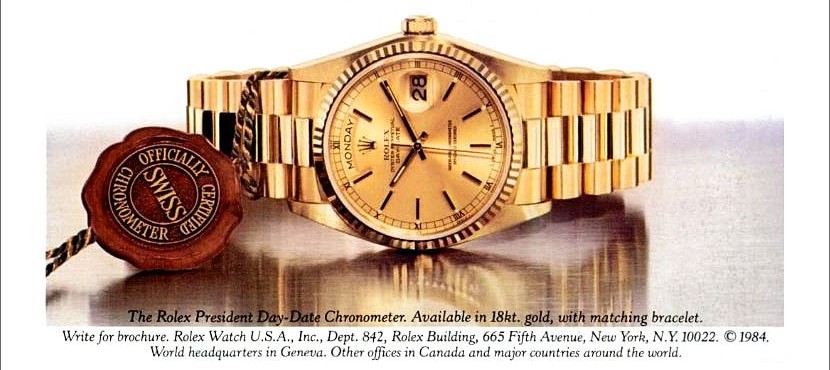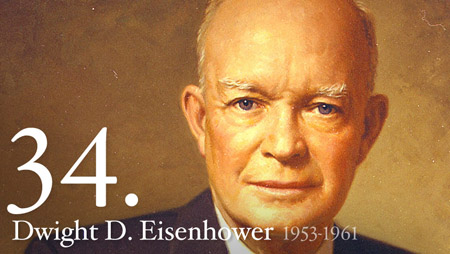In 1972 Rolex added a new feature to the President Day-Date. The technology allowed for wearers to stop the second hand if he or she wanted to reset the time to fit another more accurate source. Later in the 70s, the Day-Date added the “Quick Set” feature. This feature allows for a crown to be easily pulled out to readjust the date, rather than having to turn the entire crown.. Read More
Rolex Day Date President Part 1: History of Rolex’s Flagship Watch
Rolex Day Date “President” This new 6511 the “Day Date” had a window at 12 spelling out the day at 12 and the date was shown at 3. Due to the complexity of the watch, with its automatic movement, additional day and date discs and a screw down back it was a very large and thick watch which gave it presence on the wrist. Introduced as a niche model it soon gained.. Read More
Presidents and their Timepieces – George W. Bush and Barack Obama
During his campaign, and perhaps afterward, George W. Bush wore a Timex i-Control alarm watch, which Timex billed as “the world’s easiest to use alarm watch.” (He no doubt liked it also because of his famous concern with promptness.) To set the alarm, the wearer need only turn the bezel to the desired time and pull out a crown at 4 o’clock. Barack Obama During his campaign, Barack Obama often.. Read More
Presidents and their Timepieces – George H.W. Bush and Bill Clinton
George Herbert Walker Bush may very well have been done in by his watch. In one of the most famous incidents in watch history, Bush dealt his re-election bid a blow when, during a televised debate with Bill Clinton and Ross Perot on Oct. 15, 1992, he twice glanced at his watch as if he were bored with the proceedings and had somewhere.. Read More
Presidents and Their Timepieces – Nixon and Ford
Richard Nixon In 1955, Vice President Nixon was given a Vulcain Cricket after speaking to the National Association of Watch and Clock Collectors. In 1960 he sent the Cricket in for services and stated “It has given excellent service over the past five years and has served as my alarm clock around the world.” Omega Speedmaster In 1969 after the moon landing, Omega created a gold version of the Speedmaster Professional (caliber 861) to.. Read More
Presidents and their Timepieces – LBJ
Patek Phillippe LBJ is the only US president confirmed to have owned a Patek Philippe watch. His was a reference 2526 in 18k yellow gold and was ordered through Tiffany and Company with a special yellow gold Tiffany bracelet. Around the center of the watch’s enamel dial it states “Do Unto Others As You Would Have Them Do Unto You,” known also as the Golden Rule. The watch is in the collection of the.. Read More
U.S. Presidents and their Timepieces – John F. Kennedy
Omega Ultra Thin When President John F. Kennedy took the Oath of Office on January 20, 1961 he did so while wearing an Omega Ultra Thin (Reference OT3980). The watch was given to him by then Florida senator Grant Stockdale and included the inscription “President of the United States John F. Kennedy from his friend Grant” on its caseback. While Kennedy had the.. Read More
U.S Presidents and their Timepieces – Dwight Eisenhower
President Eisenhower owned a Heuer chronograph, Rolex Datejust, Vulcain Cricket, and a Vacheron Constantine. Vulcain Cricket Eisenhower was a fan of the Vulcain Cricket and owned one before taking office. The Cricket model was known for its rather loud builtin alarm, which, according to the story, caused a bit of an awkward political moment during one of the president’s press conferencesthe alarm on his Swiss watch interrupted him during a conference meant to encourage.. Read More
U.S. Presidents and their Timepieces – Harry Truman
There are a handful of watches believed to have been owned by President Truman. Some are engraved and show evidence of actually having been owned by the President, whereas others were not. This confusion stems from a jewelry auction of items from the state of Margaret Truman Daniel, the only child of the former president and his wife, First Lady Bess Truman. Some of the items were definitely owned by the president, whereas some.. Read More
Mark Sirianni Jewelry Repair
Ring sizing, Watch and Jewelry Repair, $3.00 Watch Batteries I have 38 years of experience as a watchmaker and Jeweler. I do ring sizing and all types of jewelry repair. I can take care of all of your watch and jewelry repairs from my shop at 25 Fraley Street. I am open weekdays Monday–Friday from 8-3. Call for more info 837-9435 Cell 1-814-558-4818 I can install.. Read More





